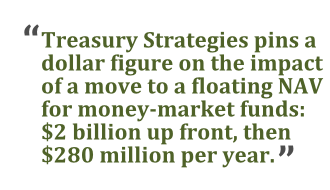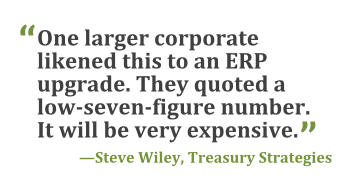The U.S. Securities and Exchange Commission (SEC) is currently considering a proposal that would require institutional investors to account for their holdings in prime money-market funds—those that invest in short-term corporate debt—using a variable net asset value (NAV), rather than the stable NAV that is currently the industry standard. The proposal was announced in June, and the deadline for comments is September 17.
The goal would be to increase transparency, in order to avoid a run on money funds in future financial crises like the run that occurred in September 2008 when the Reserve Primary Fund “broke the buck,” repricing shares below $1 to devalue investors' holdings. Critics of constant NAV money funds argue that their constant $1 price masks movement in the market and that if they're going to promise liquidity on par with bank accounts, they should be regulated like banks. The problem is that what may seem like a fairly minor accounting change could have a major impact on corporate usage of money funds.
Consulting firm Treasury Strategies conducted a study for the U.S. Chamber of Commerce that pins a dollar figure on the impact to institutional investors of a move to a floating NAV for money-market funds: between $1.8 billion and $2 billion up front, then another $270 million to $280 million per year. Treasury Strategies came to these numbers by analyzing the effects of the change on investors in an array of different categories, including corporations of all sizes and public institutions such as municipalities and universities. “We applied a lot of different cost components and then generated a very conservative estimate,” says Steve Wiley, a manager with Treasury Strategies.
The study identified seven areas in which corporate investors would incur significant costs if they continued using prime money funds under the new proposal:
Investment policy development. Many companies' current investment policies include language that would prohibit investment in a floating NAV money-market fund. Although money funds' prices might hover around $1 per share, the SEC proposal envisions rounding to four decimal places, so prices might swing frequently. To continue using money funds, organizations might have to rewrite their investment policies to take into account mark-to-market valuations in calculating parameters for NAV fluctuations and acceptable levels of counterparty risk in money fund investments, as well as to ensure that their money fund accounting meets GAAP requirements.
“You'll need to establish acceptable net asset value parameters within investment policies, or else say that a prime money-market fund is no longer acceptable,” Wiley says. “You'll have to go through the process of having the board and senior executives review and approve that policy. Then there's another dynamic. An institutional investor's counterparty risk policy specifies the total amount of exposure across all financial instruments—credit facilities, bank balances, investments, derivatives—that you're willing to accept with a particular counterparty. That will have to change a little bit as well, to factor in the mark-to-market position for the company's money-market funds.”
Investment process reengineering. Today, processes for initiating and redeeming holdings in money-market funds are usually as simple as transferring funds between accounts. Treasury Strategies anticipates that if money funds moved to a floating NAV, companies would have to take the extra step, before every initiation, of verifying that the investment instrument is acceptable at its current net asset value. This step would need to be taken during automatic sweeping of funds into money-market accounts, which would obviously complicate that process, possibly requiring automatic sweeps to involve a great deal more manual intervention.
“Companies will have to put in place a confirmation process,” predicts Paul LaRock, a Treasury Strategies principal. “Right now, when you buy or sell a money-market share, you know the price: It's a dollar. With the floating NAV, the price will vary slightly up and down around a dollar. Buyers and sellers will have to confirm with each other the exact purchase price, out four digits right of the decimal, just like when they trade ultrashort bond funds or equities. That will require a formal confirmation process to be put in place. To the extent that a buyer and a seller have slightly different prices on a trade, there will have to be an exception resolution process to mitigate those problems, and that will require staffing. When they don't match, people will have to get on the phone and fix it.”
Intraday liquidity management. Even more problematic, financial institutions may no longer be able to accommodate intraday settlements if money funds move to a floating NAV. “The companies we interviewed had a lot of concerns around intraday liquidity management,” Wiley says. “It's unclear right now how frequently the net asset value would be published, but corporates may have to redeem funds from money-market investments on a prior-day basis for next-day value. That would eliminate money-market funds as a practical cash-equivalent liquidity instrument. If they lose that key utility, that's going to drive corporates into other instruments that can meet the intraday liquidity management provision.” In other words, companies would have to decide between riskier investments or non-interest-bearing accounts for parking cash.
Accounting practices. It's unclear whether money-market funds would change from cash-equivalent instruments, which don't require reporting on daily changes in value of the portfolio, to available-for-sale securities as defined by U.S. GAAP. If the funds' GAAP status changed, companies would have to monitor their mark-to-market value and account for gains or losses on the balance sheet.
“On the balance sheet, there are going to be unrealized gains or losses,” LaRock says. “But when you buy and sell the shares, you're generating realized gains or losses. Companies will have to adopt either a LIFO [last in, first out] or FIFO [first in, first out] valuation approach so that when they liquidate they know which shares they're selling. They're going to have to develop that protocol and then calculate the realized gains or losses on those shares, just as they would with equities.”
Tax reporting. If money-market funds adopted a floating NAV, all sales of money fund shares would become tax-reportable events. Corporate tax and treasury functions would need to capture each trade's share identifier/name, acquisition cost, and holding period. They would also have to recognize whether a security sale meets the IRS's “wash rule,” which prohibits a company from recognizing a loss on the sale of a security when it purchases a replacement security within 30 days.
Treasury Strategies predicts that moving money funds to a floating NAV would require between one-half and one additional full-time equivalent (FTE) employee for the typical company. Much of Treasury Strategies' estimated increase in annual operating costs, a total of $270 million to $280 million across the U.S., derives from that extra staffing. “The ongoing costs would mostly be around additional resources they'd need across treasury, accounting, and tax,” Wiley says. “This is a real pain point for the corporate treasury folks we talked to. We talked to one university that said they'd have to hire an additional person to develop and manage the new procedures—and they were worried the skill set would be hard to find because it would be in high demand.”
System reengineering. The complexities that a floating NAV would introduce in accounting, tax reporting, and initiation and redemption of money-market funds would likely require a company to upgrade, if not replace, software systems. “As a rule of thumb, the more complex the system and the greater reliance on automated procedures within the systems to transact with money-market funds, the more expensive and elongated the compliance period will be,” Wiley says. “Corporations use a number of different systems to manage investment activity. For companies that manage money-market fund activity within a treasury management system, an ERP, or another specialized software package, the move to floating NAV will be very expensive because they are going to be dependent on the system providers for upgrades. And after the upgrades are available, they're going to rely on system vendor consultants or implementation resources to configure those systems.
“One larger corporate we talked to likened this to an ERP upgrade,” Wiley adds. “They quoted a low-seven-figure number. It will be very expensive.”
Debt issuance. Treasury Strategies anticipates that a move to a floating NAV would make money-market funds less attractive to corporations. “They would probably not be comfortable using the institutional prime funds because of the investment in time and money required to administer those funds if this proposal were to go through,” LaRock says. Ultimately, this might shrink the market for commercial paper and drive up borrowing costs.
Treasury Strategies has developed a cost calculator to help companies determine how much it would cost them to continue using money-market funds if the SEC proposal were adopted. The calculator divides costs into five high-level categories and then subdivides each of those into more specific expenses. The firm strongly recommends that money fund users perform these calculations, then contact the SEC with the results.
“The SEC is sincere in wanting input from institutional investors,” LaRock says. “They don't know everybody's internal costs, and they sincerely want to have a deeper understanding so they make a good decision. This is not a topic that people should be passive on. To the degree that they can estimate costs, the staff at the SEC would love to see that. Corporate treasurers should take up the SEC on its request for input before the SEC makes a decision.”
——————-
Meg Waters is the editor in chief of Treasury & Risk. She is the former editor in chief of BPM Magazine and the former managing editor of Business Finance.
© Touchpoint Markets, All Rights Reserved. Request academic re-use from www.copyright.com. All other uses, submit a request to [email protected]. For more inforrmation visit Asset & Logo Licensing.



